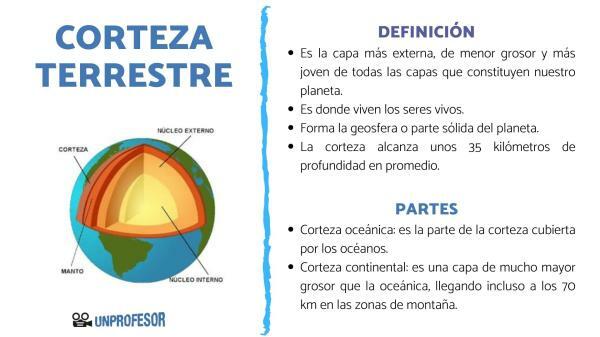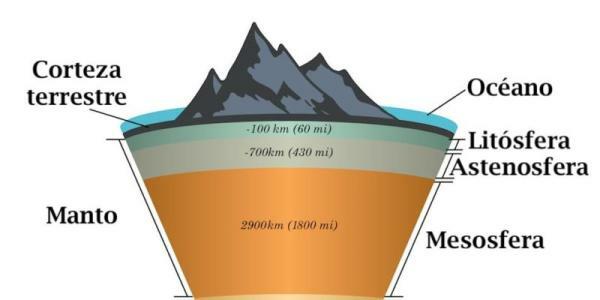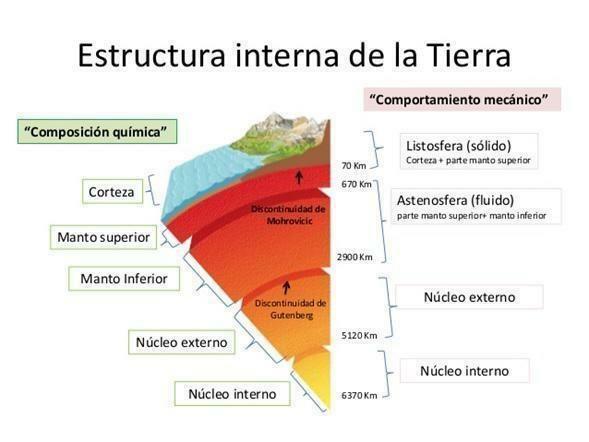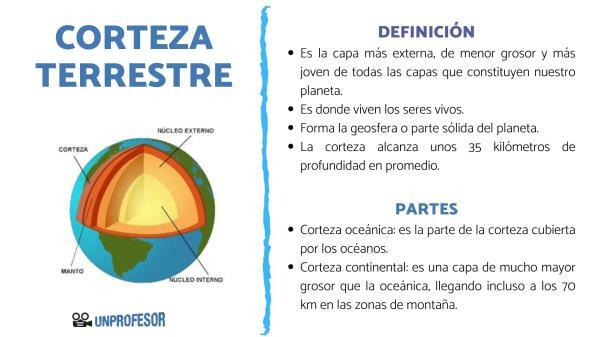What is the EARTH'S crust and its parts

Our planet Earth is divided into several layers. In a general division, these are from the inside out, the Earth's core, mantle, and crust. The crust is, therefore, the most superficial layer of the earth and is of great importance, since it is in it that living beings live. In this lesson from a TEACHER we will talk about the earth's crust and its parts. Here we tell you more!
Index
- What is the earth's crust and what are its parts?
- Characteristics of the earth's crust
- How was the earth's crust formed?
- movements in the earth's crust
What is the earth's crust and what are its parts?
The earth's crust is the outermost layer, thinnest and youngest of all the layers that make up our planet. It is a very important layer, since it is in it that living beings live, even those that live on the ground.
the bark forms the geosphere or solid part of the planet, together with the mantle and the Earth's core.
parts of the earth's crust
The crust reaches about 35 kilometers deep on average, but it is not uniform throughout its length, since it varies according to the two fundamental parts into which it is divided. These are:
- oceanic crust: is the part of the crust covered by the oceans. It is thinner (it only reaches a thickness of around 5 km) and of more recent formation. It therefore covers 55% of the planet's surface and begins thousands of meters deep under the ocean.
- continental crust: it is a much thicker layer than the oceanic layer, even reaching 70 km in mountain areas. It is of a more heterogeneous nature than the oceanic one, since it is made up of rocks that have different origins, although the majority minerals are micas, feldspars and quartz. This compositional heterogeneity makes our planet unique from other planets.

Image: Concept
Characteristics of the earth's crust.
Taking into account all the layers of our planet, the bark only occupies 1% of the volume whole land. This crust is the only layer that is known directly, although it occupies about 35 km towards the core and we only know about 12.5 km with the deepest well dug in history, which was made by the Soviet Union and is called the Kola Superdeep Well (KSDB).
The earth's crust forms the upper part of the lithosphere and is separated from the upper part of the mantle by the Mohorovicic discontinuity. The crust is less dense than the mantle, so it floats on top of it. The temperature in the crust is found to vary up to 400 ºC, increasing at a rate of 30 ºC per kilometer of depth.
Among the chemical elements that form it is oxygen (56.6%), silicon (27.7%), aluminum (8.1%), iron (5%), calcium (3.6%), sodium (2.8%), potassium (2.6%), magnesium (1.5%) and other elements and water with less than 1%.

Image: Pinterest
How was the earth's crust formed?
Now that you know what the earth's crust and its parts are, let's find out what its origin was. It is believed that the first crust of the earth was formed 4.4 and 4.55 billion years ago. From that moment on, the volume of this crust has been increasing with the deposition of new layers as conditions on Earth became more stable and the planet's temperature descended. Was two great geological events 2500-2700 and 1700-1900 million years ago that increased the volume of the crust considerably.
Earth's crust is in continuous training. In this process, some parts of it sink into the mantle by subduction and merge into the magma. from the interior of the mantle, while other parts emerge at expanding centers of the crust oceanic. On average, the age of the continental crust is estimated to be about 2 million years, while the oceanic crust is much younger.
movements in the earth's crust.
The earth's crust is not static. but it presents certain movement of the plates that form it. These plates are found floating on the mantle, that is, a pasty material that is subjected to great pressure. This results in a slow movement of the crust, known as tectonic dynamics. This causes, in turn, that the different plates rub and collide each other, giving rise to much of our planet's orogenesis, such as the formation of mountains when the crust folds and bulges.
can also be generated depressions and tectonic faults and it can happen that one plate submerges under another, liquefies, and increases the pressure inside the magma, causing it to come out, giving rise to volcanoes. Therefore, the movement of this earth's crust gives rise to the relief of our planet.
Another effect of this movement is the seismic waves and tremors generated by the friction of the plates, and can be transmitted to the surface with devastating effects. Finally, the movement of the great continental loops around the planet causes a drift continental, which formed from the ancient supercontinents like Pangea, to the configuration in the present.

If you want to read more articles similar to Earth's crust and its parts, we recommend that you enter our category of geology.
Bibliography
- Holmes, A., Vila, R. C., & de Candel, J. c. (1962). Physical geology. Omega.
- nice, j (1997). Deformation of the rocks of the earth's crust. Teaching of Earth Sciences, 5(2), 149-158.
- Garcia-Ordaz, M. I (2018). Dynamics of the Earth's Crust. Con-Science High School Science Bulletin No. 3, 5(10).



